Classification of taps for radiators + installation technology
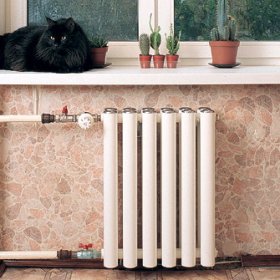
A centralized or individual heating system needs adjustment. Weather has a nice property to change, but the temperature of the coolant in the system most often remains unchanged. As a result, there is a sad picture: outside the window - frost, and in the rooms - tropical heat. Owners of private houses with individual heating can fully control the air temperature in each room thanks to modern automation systems.
But there is a less expensive way to regulate the flow rate of the coolant - the installation of taps on radiators. The presence of these simple but useful devices also makes it possible to carry out repair and maintenance of radiators more efficiently, because with the help of such taps you can disconnect the radiator from the system at any time and then just connect it again.
Content
Why do I need a faucet on a heating battery
When installing a modern heating system, even at the stage of its development, the master will definitely recommend the customer to install taps on radiators. As a result, the owner of the object receives a number of advantages:
- This is the previously mentioned opportunity to disconnect / connect the battery, regardless of the time of year or the heating season. The battery may clog, break, leak, and a simple turn of the valve will stop the flow of coolant and will allow you to immediately carry out the necessary manipulations with the device.
- If the apartment or house becomes too hot due to sudden warming, to which the heat providers did not have time to respond in a timely manner, simply turn off the battery. When the temperature reaches a comfortable level, the battery is turned on again.
- The crane installed at the bottom of the radiator allows you to quickly and accurately drain the coolant into a separate tank or even immediately into the sewer before dismantling. This will significantly save time and effort on cleaning after repair or replacement of the radiator.
- The presence of faucets allows regular maintenance of the radiator in order to remove contamination and air entering the pipes from the system. As a result, the battery lasts longer and the quality of heating improves.
Sometimes apartment owners worry that the faucet can easily leak or break. To avoid this, you should choose high-quality equipment, as well as carefully observe the installation technology.
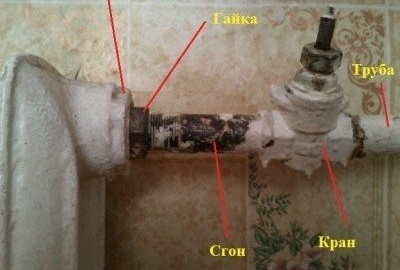
The photo shows an image of a conventional ball valve mounted on a heating battery, and the main elements of this design are indicated
You may be interested in material about the types of radiators, their advantages and disadvantages: https://aquatech.tomathouse.com/en/otoplenie/radiatory/kak-vybrat-radiatory-otopleniya.html. Having studied it, you can quickly choose heating batteries for a house or apartment.
The device of the ball valve and their types
For installation on radiators ball valves are usually used. This is a relatively simple device that consists of the following elements:
- gate;
- stem with seal;
- sealing washer;
- sealing seats;
- case and adjusting nuts;
- control knob;
- body.
The shutter is a metal ball in the center of which a hole is made. The handle allows you to move the shutter in one of two positions: “closed” or “open” - by turning 90 degrees. Such a simple device provides reliable design and a relatively low price.
Most often, ball valves are made of durable brass or similar alloys, they also use durable modern plastics and effective lubricants. Another advantage of the ball valve is its compact size. For a small device, it’s easier to find the right place in the system.
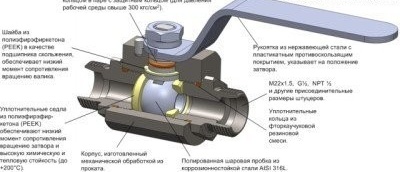
The diagram shows in detail the design of a ball valve, which allows you to understand the principles of operation of this simple and reliable design.
Depending on the bandwidth, there are:
- full bore;
- standard;
- partial bore ball valves.
The former pass 90-100% of the coolant flow, the latter - about 70-80%, and the third - only 40-50%. For mounting on a radiator, it is recommended to install full bore structures that will ensure the absence of significant obstacles to the coolant, which favorably affects the efficiency of heating the room.
On sale you can find ball valves made of plastic, but they are not suitable for hot water supply or heating pipelines, since they do not tolerate high temperatures. Brass ball valves for radiators are also distinguished by the installation method:
- coupling;
- flanged;
- welded;
- combined.
Coupling taps are usually recommended for use in the installation of heating systems, they are also suitable for water and gas pipelines. They are used both in residential premises and in the arrangement of public buildings. These are small devices that are easy to operate and very reliable. They are easy to install, and special sophisticated equipment is usually not required. Such structures are mounted on pipes with a cross section of not more than 40-45 mm.
When choosing valves for larger pipelines, it is recommended to pay attention to flange designs. They are designed for pipelines with a diameter of more than 50 mm. During installation, special gaskets should be used to ensure sufficient strength and tightness of the connection of the valve and the pipeline. Flanged ball valves are strong enough to be used in heating systems.
There are collapsible flanged taps and non-collapsible. The first ones have a collapsible case, which will be very convenient when replacing worn or damaged parts. Most often, replacements require gaskets, sometimes you have to put a new shutter, etc. Non-separable flanged taps have a solid body. In the event of a breakdown, the entire structure must be completely replaced.
Welded structures are installed by welding, as the name implies. Since dismantling of this design cannot be called simple, devices of this type are installed in places with limited access. Weld ball valves should only be specialists who have the necessary qualifications.
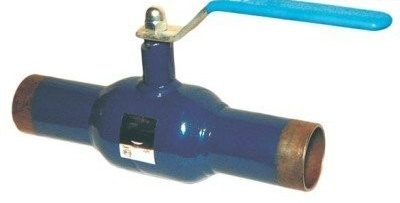
Welded ball valve is quite difficult to install, because you need to carry out skillful welding. Such devices are installed in places that cannot be easily accessed.
Combined designs may combine several mounting methods. Such cranes can be straight through, angular, multi-way (for example, three-way). The latter type is not often used in the installation of heating systems, since it is used in systems where mixing or redirection of various environments is necessary.
Although faucets made of brass or its alloys are best used for heating systems, silumin adjusting structures that are less durable and cheaper can be found on sale. Outwardly, they are very similar to brass taps and can pass as expensive originals by unscrupulous sellers. Before buying, you should consult with a professional master who will help distinguish fake and make the right choice.
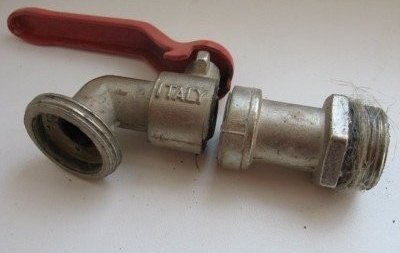
Silumin ball valves are inexpensive, but have low resistance to stress and corrosion. Such designs should not be installed on radiators
Silumin structures in heating systems withstand loads for no more than a year, then they break. This material does not tolerate increased loads, such as water hammer, is noticeably susceptible to corrosion. Sometimes a silumin faucet for a heating battery simply falls off the pipeline when closing or opening the faucet. This can lead to significant and serious burns. In addition, when using low-quality taps, leaks often occur. As a result, more than one floor can be flooded.
Before buying heating pipes and faucets, you need to calculate the number of sections of radiators in order to ensure good room heating. You will learn how to do this correctly from our article:https://aquatech.tomathouse.com/en/otoplenie/raschety/raschet-kolichestva-sektsiy-radiatorov-otopleniya.html.
Installation procedure
The easiest way to install a flanged ball valve is a very popular design. To install such a crane, you must:
- Choose a suitable place.
- Wrap tap thread with a sealant, for example, FUM tape.
- Screw on tap.
- Check connection points for leaks.
When figuring out how to put the tap on the battery correctly, one should take into account a number of nuances that will help to correctly perform these operations. For example, if a tap is inserted into an already finished system, a small part of the pipe should be cut and a suitable thread cut, if one is missing. You can see more useful installation information in the video:
Of course, before starting work, you will need to remove the coolant from the heating system. Owners of private houses with individual heating will not have problems, but apartment residents will have to coordinate this event with the management company.
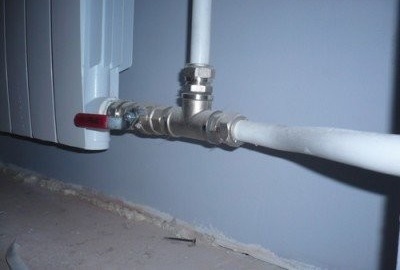
The ball valve is installed in the area between the battery and the bypass - a special jumper that circulates the coolant in the system, even when the valve is closed
The faucet is installed in front of the battery and behind the jumper, which connects the “input” and “output” of the coolant, so that when the flow is blocked, the coolant does not stop circulating through the system. If such a jumper (professionals call her bypass) missing, when installing the faucet on the radiator, this problem must be solved. When installing a crane, two points should be considered:
- There should be no obstacles to the adjusting knob installed in any position.
- The user should have easy access to the crane.
Before purchasing a crane, of course, you should make sure that the diameter of the crane and the pipe on which it will be installed correspond to each other. The type of thread is also worth clarifying. For a flanged valve, these elements can be made as follows:
- both threads are internal;
- both threads are external;
- combination of internal and external threads from different sides.
On flanged valves there is a special marking in the form of an arrow, which indicates the direction of flow of the working medium, i.e. coolant. Do not neglect these instructions when installing the crane.
To avoid leaks, use FUM tape or another suitable sealant correctly. In the case when the valve is installed on a pipe with an open thread (it is clear that the thread will be closed on the valve flange), the seal is wound clockwise.In this case, the master is facing the hole in the pipe. If the open thread is on the flange, the seal is also wound clockwise, but already facing the tap, not the pipe.
When the FUM tape is wound correctly and in sufficient quantity, noticeable efforts will be required to screw the thread. At the end of the work, part of the sealant may protrude slightly at the junction, this is a completely normal situation, typical for good sealing. If the crane turns easily, a too thin layer of sealant is used. In this case, wrap some more FUM tape, and then tightly screw the tap to the pipe. Compliance with these simple rules will help to install the crane correctly and provide a sufficiently high sealing.
At the end of the work, it is necessary to check the connection by filling the system with water, preferably at high pressure. Neglect of this rule can lead to flooding of the room due to improper sealing of the joints. Most often, tenants of apartment buildings suffer from the consequences of dishonest work, since filling the heating system with water before the start of the heating season is usually carried out without warning on a weekday.
A few words about the Mayevsky crane
In addition to conventional ball valves, there is a mechanism that is specifically designed for radiators - Mayevsky crane. This device is not necessary to regulate the flow of the coolant, but to remove air that has somehow got into the stream. At the heart of the device is a needle mechanism specially designed for these purposes.
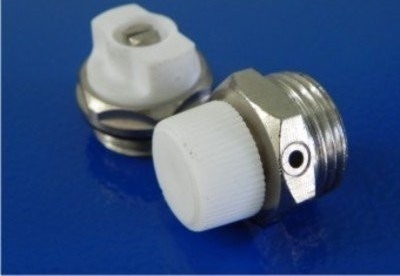
Mayevsky crane is a small device that is usually installed at the highest point of the heating system to bleed air that has got into the pipes
There are two types of Mayevsky cranes - a simple mechanical model and an automatic device. The first is controlled manually, the second is adjusted accordingly, and it turns on when necessary. Removing air from the heating system helps prevent the formation of air jams and increase the efficiency of the system.
Install Mayevsky cranes at the highest point in the system, where air accumulates. If the system works with forced circulation, it is recommended to turn off the pump and wait a while before turning on such a tap.
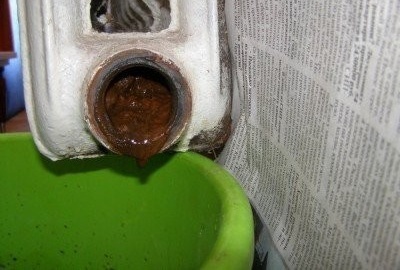
When choosing a crane for a cast-iron battery, it should be remembered that in such designs a lot of pollution accumulates, which create an additional load on the crane
You may need material with instructions for installing heating radiators:https://aquatech.tomathouse.com/en/otoplenie/radiatory/podklyuchenie-radiatorov-otopleniya.html.
Mayevsky automatic tap is usually used only in autonomous heating systems. In this case, the owners of the house can control the quality of the coolant, regularly clean the system, etc. In apartment buildings with centralized heating, models of the Majewski crane with manual control are used, they are more durable and better resist the pollution that is characteristic of the coolant in public systems. Automatic models in such conditions clog and break very quickly. Especially attentive to the condition of the taps on the radiators should be those who have old cast-iron radiators in the house.
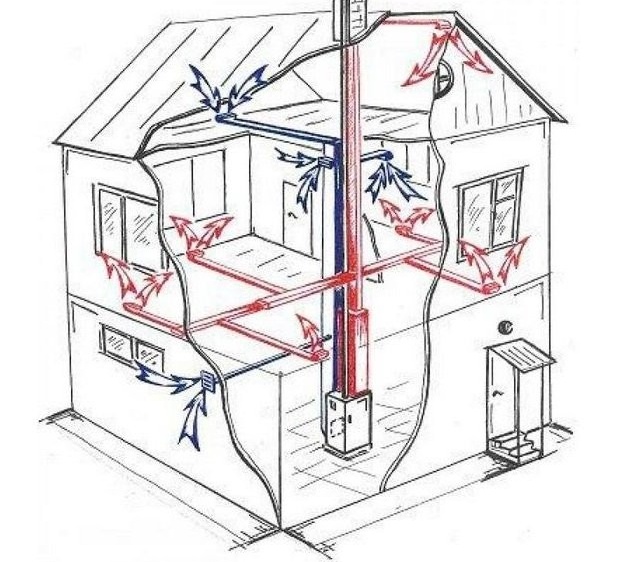
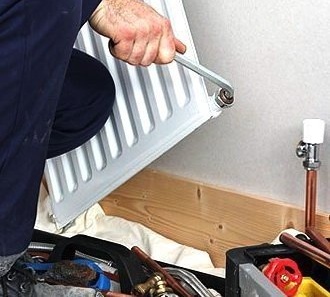
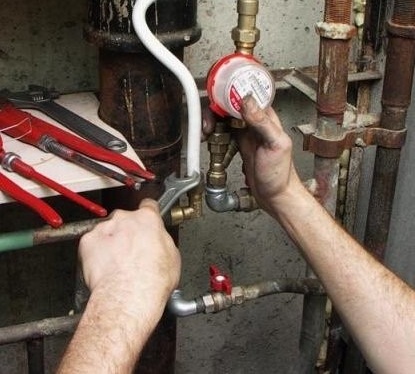
3 comments